Health Insurance
66% of Americans Want Health Insurance Companies to Cover Alternative Medicine
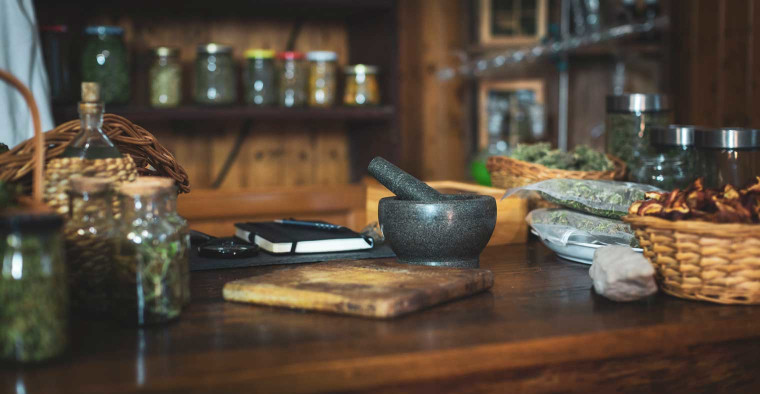
There are many ways to define health and wellness. In turn, there are many ways to achieve what one might consider good health or wellness. Some might say seeing a doctor and taking prescription medication is part of being healthy, while others might say nature provides all the healing they need.
ValuePenguin researchers surveyed 1,100 consumers to explore these healing habits. Given the popularity of activities like yoga and products like essential oils, it makes sense that 55% of consumers say they use at least one form of alternative medicine or natural remedy.
- Key findings
- More than half of Americans use alternative medicines and natural remedies
- Younger consumers are less likely to have health insurance, more likely to use alternative medicine
- Chicken noodle soup, ibuprofen on the side — consumers often mix home remedies with conventional medicine
- Red pill or blue pill, most consumers want to avoid medicine if they can
- Cutting costs without cutting care
- Methodology
Key findings
- Alternative medicine is pretty mainstream. 55% report using at least one form of alternative medicine or natural remedy to treat a health problem — most commonly herbal medicine, supplements or teas (24%). That’s followed by essential oils (18%) and chiropractor visits (15%).
- Younger Americans are more likely to use alternative medicines. Just 44% of baby boomers use alternative medicine, compared to 67% of Gen Zers.
- A lack of health insurance coverage presents problems for some fans of alternative medicine. Nearly a third of Americans have had trouble getting their health insurance to cover alternative medicine treatments, and the majority of consumers (66%) want to see these types of treatments covered by insurers.
- Most consumers use a mix of conventional and alternative medicine depending on the symptom or condition. Allergies are the top condition consumers would treat with conventional medicine, while sore throats take the top spot for the symptom Americans would treat using alternative or natural medicine.
- Many Americans are hesitant about taking conventional medication, as some believe doctors are too quick to prescribe pills. 72% try to avoid medication when possible, and 62% of consumers think doctors are too quick to prescribe medication.
More than half of Americans use alternative medicines and natural remedies
Did your mother tell you to gargle warm salt water when you felt a sore throat coming on? Natural remedies and alternative medicines appear quite popular, with 55% of respondents admitting to using some form. The recent explosion of the wellness economy — with seemingly more choices than ever for fitness machines and memberships, mental health support and even wellness tourism — has likely brought more attention to these forms of health care.
Influencer culture has likely also helped drive the popularity of alternative medicines, given how many influencers promote fitness teas, weight-loss shakes or other dietary supplements. Herbal medicines, teas and supplements are the most popular form of alternative medicine, with 24% of respondents currently using them. Essential oils come next in popularity, with 18% of consumers dabbling.
Those who use alternative medicine aren’t just experimenting at home, though. Fifteen percent of respondents report seeing a chiropractor as a form of alternative medicine. Additionally, 14% of people use yoga or meditation for healing, some of whom may visit studios or retreats to do so.
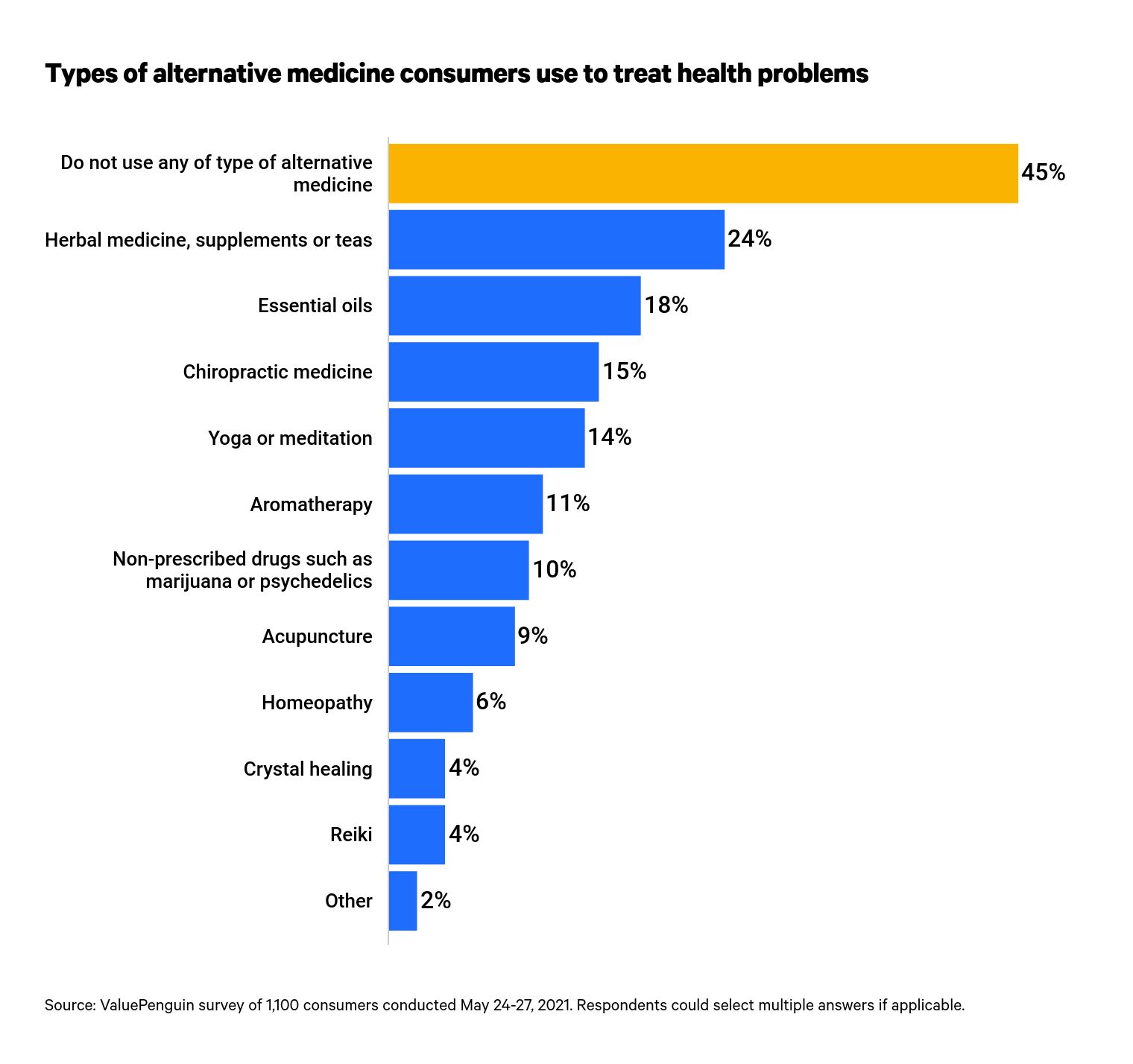
Younger consumers are less likely to have health insurance, more likely to use alternative medicine
A prophetic tweet once said, "Generation Z will punch a cop in the face but be afraid to make a doctors [sic] appointment on the phone." ValuePenguin doesn’t have the data to corroborate either of those claims, but researchers did find Gen Zers are more likely to use alternative medicine than their elders. In fact, 67% of consumers ages 18 to 24 have used at least one form of alternative medicine, compared with 44% of baby boomers (ages 56 to 75).
U.S. Census Bureau data finds that Gen Zers and millennials (ages 25 to 40) have the highest uninsured rates among adults, which could contribute to the younger generations being more likely to use alternative medicine.
Health insurance may not help lower the cost of alternative medicine — 31% of respondents have had trouble getting their insurers to cover alternative treatments.
"Health insurers will usually require that you prove that the alternative medicine or care is necessary, and — as such — you'll have to show some type of proof that you need that specific care," ValuePenguin insurance analyst Sterling Price says.
Coverage varies by policy and provider, which means some insurers may cover chiropractic care, for example, while others won’t.
Still, cost doesn’t appear to be a major deterrent or advantage of alternative medicine or natural remedies. Only 22% of adults say they use alternative medicine because it’s cheaper than conventional health care.
Most current alternative medicine users — 62% — estimate they spend less than $100 a year on treatments. But given the majority of consumers — 66% — would like to see alternative treatment options covered by health insurance, it’s conceivable more adults would try these options if they were covered.
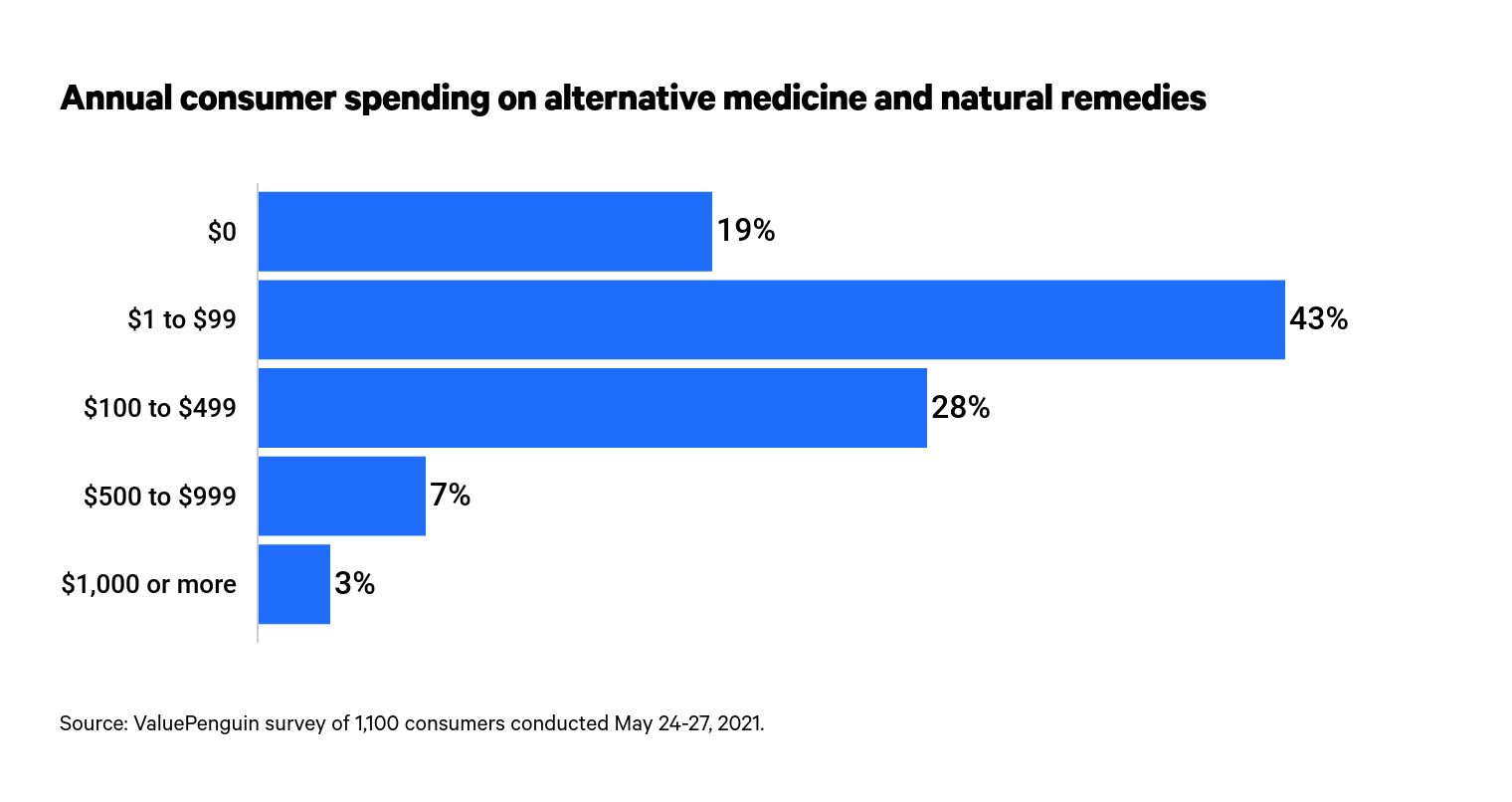
Chicken noodle soup, ibuprofen on the side — consumers often mix home remedies with conventional medicine
When choosing between a natural remedy and conventional medicine, consumers may be influenced by their symptoms. For instance, most people head straight to the medicine cabinet when allergy season arrives, with 63% relying on conventional medicine for relief. Similarly, 60% of folks reach for a pharmaceutical when they need to kick a headache.
Though natural remedies alone never win a majority for the conditions listed, a fair share of individuals sometimes rely on these methods. When it comes to sore throats, 28% of consumers try natural remedies — maybe all those warm salt water enthusiasts. Additionally, 24% would prefer alternative treatments for either stomachaches or mental health concerns.
Many consumers also combine approaches to health when it comes to treating various problems. Considering ice is technically a natural remedy, it’s not surprising 28% of consumers combine the natural with the medical to treat muscle aches. Likewise, 27% of mental health patients would address their illness with prescription drugs and alternative remedies like meditation.
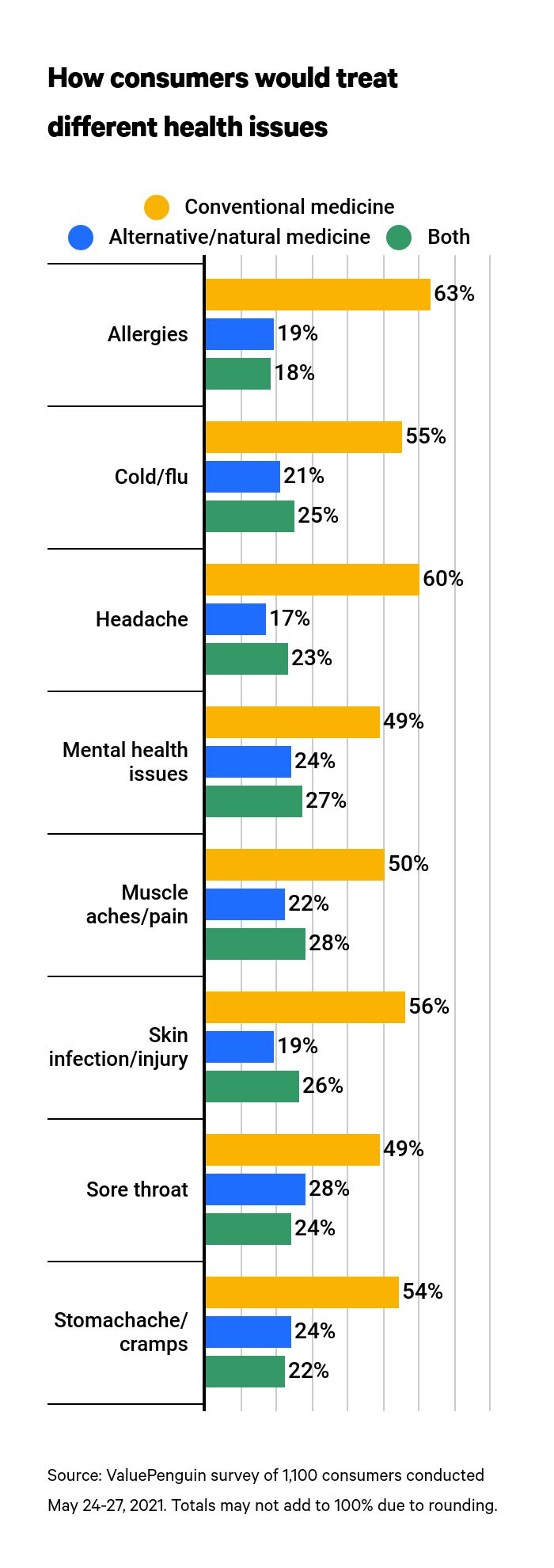
Red pill or blue pill, most consumers want to avoid medicine if they can
Modern medicine has certainly done wonders for human progress, but it has not been without its troubles. Most recently, Americans have seen the way vaccines can battle a devastating pandemic.
But on the flip side, they have seen how the opioid crisis has spun out of control due in large part to doctors overprescribing the pain medications. Through both crises and beyond, social media and the internet at large contribute to uncertainty with their unlimited supply of facts, opinions and biases.
All these conditions make it pretty logical that 72% of consumers try to avoid medication whenever possible. While the largest share of respondents trusts the effectiveness of conventional medicines over natural remedies, part of the hesitation may come from the commonly held belief that doctors are too quick to prescribe medication, with 62% of consumers concurring.
Regardless, those who use alternative medicines seem to be looking for what works and what they think is right for their bodies. Just over half of those who use natural remedies do so because they are effective or because they think those remedies are better for their bodies.
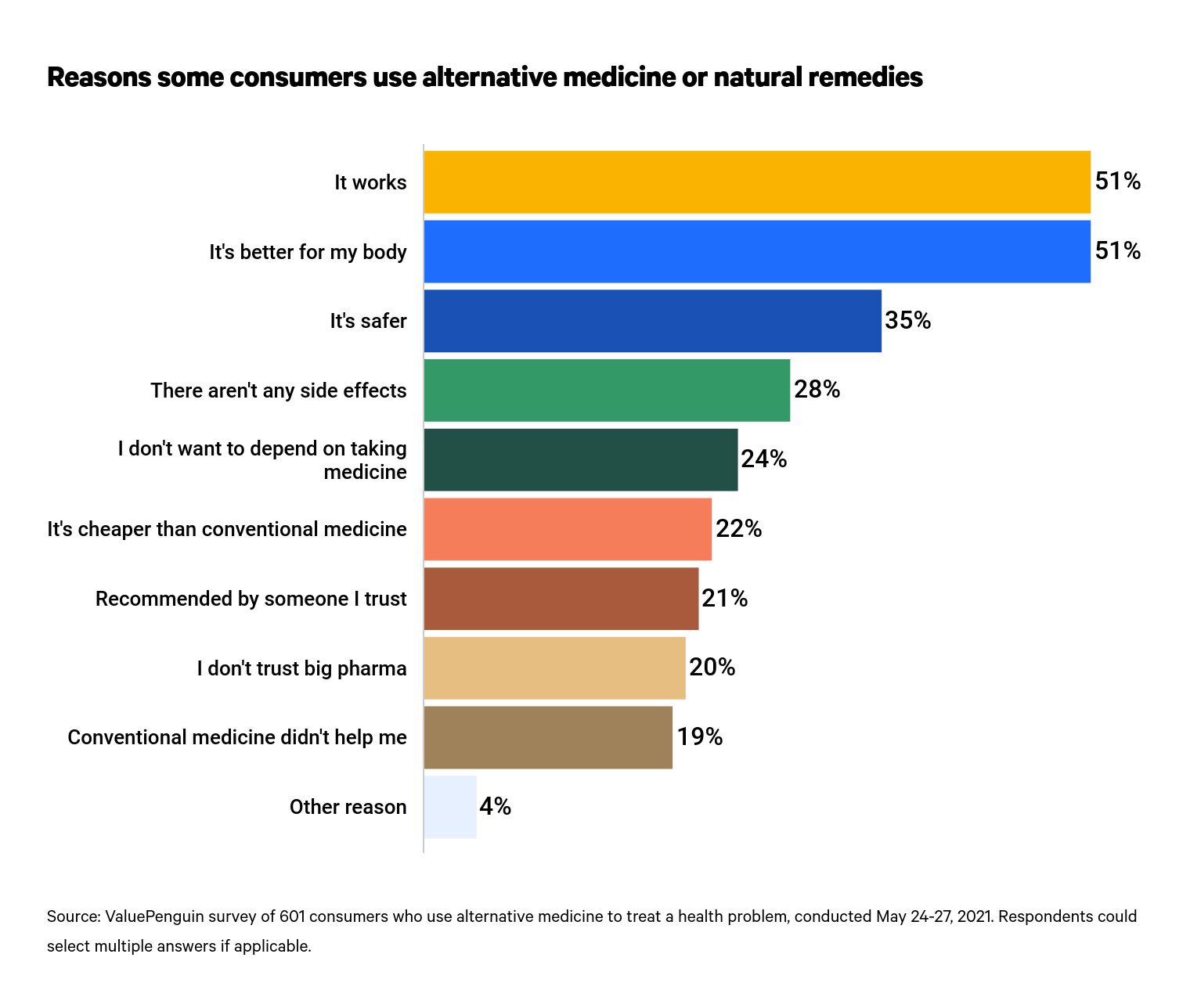
Cutting costs without cutting care
In the U.S., the cost of health care and who should pay for it have long been debated. But when it comes to individuals and their own care, consumers should use caution when looking to save money on their health. Medical debt is an unfortunate reality for plenty of Americans, but deferring treatment could wind up costing even more.
While doctors certainly advise patients to use natural healing such as rest, hydration or diet change when appropriate, forging forward without professional advice when a person is unsure how to treat an ailment can be dangerous and costly.
"If you purchase something that you think you need and it ends up not working, then you will have to go and try another treatment," Price says.
Of course, health care providers don’t always cure the problem on the first try, but it’s likely their credentials and experience will help prevent that, or at least better predict it.
For consumers less concerned with cost and more open to health care professionals, Price says a point-of-service (POS) or preferred provider organization (PPO) plan might be a better option to give individuals more freedom to choose where they receive care.
Methodology
ValuePenguin commissioned Qualtrics to conduct an online survey of 1,100 U.S. consumers from May 24-27, 2021. The survey was administered using a non-probability-based sample, and quotas were used to ensure the sample base represented the overall population. All responses were reviewed by researchers for quality control.
We defined generations as the following ages in 2021:
- Generation Z: 18 to 24
- Millennial: 25 to 40
- Generation X: 41 to 55
- Baby boomer: 56 to 75
While the survey also included consumers from the silent generation (defined as those 76 and older), the sample size was too small to include findings related to that group in the generational breakdowns.